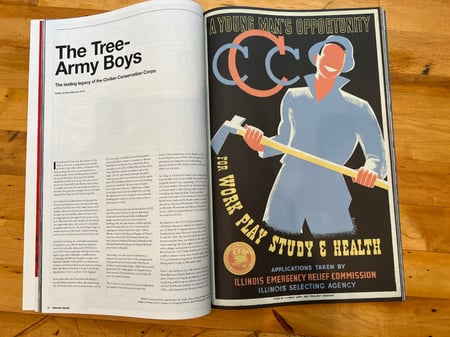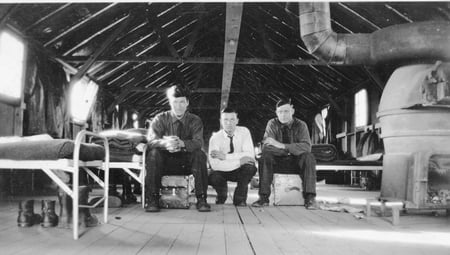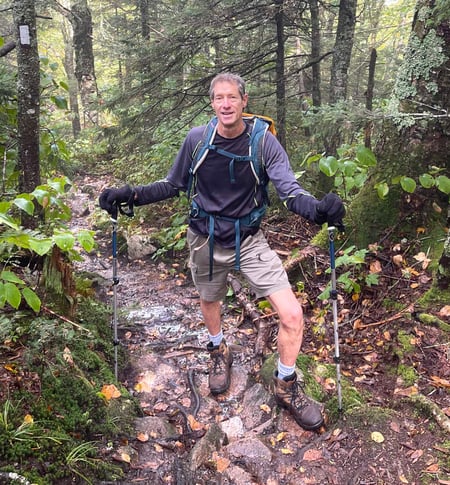Reflecting on FDR's Civilian Conservation Corps Amidst Today's Political Polarization
July 21st, 2023
5 min read

In an America beset by polarization, culture war bickering, and politicians wired to “fight” rather than solve problems, this is a mid-summer love story about a program created with true bipartisan support.
As I see it, the Civilian Conservation Corps, enacted in the first month of FDR’s presidency, is the most effective US government program in the country’s history.
This post is a much shorter version of my ten-page article in the current issue (number 199) of Mountain Gazette, a large format, bi-annual outdoor culture magazine. At 11x17, Mountain Gazette features stunning photography and fascinating long-form storytelling. It’s my favorite magazine and I’m honored to have a piece in it. (Thank you, Mike Rogge, for publishing me).
 I became interested in the CCC over the past several years as I’ve hiked on CCC blazed trails and camped in CCC built campgrounds throughout New England.
I became interested in the CCC over the past several years as I’ve hiked on CCC blazed trails and camped in CCC built campgrounds throughout New England.
My interest in the CCC blossomed into a full-blown obsession when I journeyed to a pair of Dead and Company shows at Red Rocks Amphitheatre near Denver on October 19 and 20, 2021. My little Red Rocks secret to shorter security lines is a climb to the upper gate. Upon entering the first night, I noticed a statue with a plaque and paused to check it out. Boys from the CCC built Red Rocks?!! When I learned my favorite outdoor concert venue was created under the same U.S. government program as the campsites and hiking trails I enjoy 2,000 miles away I needed to know more.
I read more than a dozen books on the CCC and hunted through dusty museums for primary source information like camp newspapers and letters written home to mothers.
In 1932, 25% of American young people were unemployed and another 25% only worked part time. It has been said that during the worst of the depression, more than 1,000 families per day were losing their homes, and a quarter million teenage tramps were riding the rails looking for a better life.
At the same time, American forests had become decimated due to reckless cutting of spruce, juniper, pine, and fir in public lands in the late 1800s and early 1900s. Forests had once covered 800 million acres in the United States, however by 1933 there were only 100 million acres of virgin timber left. The hundreds of millions of clear-cut acres meant erosion and floods became more frequent and more severe.
Upon entering office on March 4, 1933, Franklin Delano Roosevelt could have focused his presidency on any number of problems facing his new administration. Fortunately, FDR devised a plan to put young people to work on the land to replant forests, build infrastructure for camping, hiking, skiing, and other mountain-based outdoor activities, and work on the prevention of soil erosion.
Just three weeks after his inauguration, the CCC was proposed to Congress and passed a few days later with wide support from Republicans and Democrats alike in both houses of Congress as the Emergency Conservation Work Act.
The Tree Army Boys
.jpg?width=450&height=307&name=12%20CCC_boys_leaving_camp_for_home%2c_Lassen_National_Forest%2c_California_(3226900020).jpg) FDR’s CCC employed unmarried “boys” as they were called, between 18 and 25 years old, who were unemployed and whose families were on the public relief roles. They were given room and board, provided medical care, underwent training, and were paid $30 each per month, of which they were required to send $25 per month home to their families.
FDR’s CCC employed unmarried “boys” as they were called, between 18 and 25 years old, who were unemployed and whose families were on the public relief roles. They were given room and board, provided medical care, underwent training, and were paid $30 each per month, of which they were required to send $25 per month home to their families.
Thus, the CCC delivered financial benefit to the enrollees as well as their families and the communities they came from where the money sent home was spent. The act that established the CCC stated that no boys would be discriminated against, and about 10% of enrollees were Black with camps were generally segregated in the south and integrated in New England.
The Civilian Conservation Corps soon became the largest peacetime mobilization that the United States has ever seen. At peak CCC deployment in 1933, the Department of War enrolled, processed, and equipped 8,540 boys every single day, a rate greater than U.S. deployment for the Army and Navy combined during World War One. Within a year, the CCC had put about 250,000 boys to work in 1,300 camps of 200 boys each around the country that were primarily managed by and providing work for the U.S. Forest Service and the National Park Service. By the end of the program at the start of World War Two, some three million boys had served in the CCC.
For many young men, enrolling in the Civilian Conservation Corps was an act of desperation for themselves and their families. It was often the result of a long periods of unemployment and family hardship. The CCC was their way forward as much as it was a way forward for the country.
Of all the forest planting in the entire history of the United States, more than half was done in less than a decade by the CCC, more than 2.2 billion trees. It’s difficult to wrap my mind about such a phenomenal achievement: Two point two billion trees planted! A staggering 570 million trees were planted by the CCC on national forest lands alone. The CCC also implemented 21 million acres of tree pest control, spent 6.5 million days fighting fires, and built 122,000 miles of forest roads. If you’ve spent time in the mountains in the U.S., you’ve been touched by the work of the CCC.
Life was good!
 For the first time in many boys’ lives, they could eat as much as they liked. Breakfast and dinner in the mess hall were served family-style at eight person tables. The hearty, stick-to-the-ribs meals were served hot and steaming from a kitchen attached to the mess hall, and when platters were empty, they could be refilled until everyone was full. Most enrollees found the food – perhaps eggs, bacon, toast, and coffee for breakfast and meat, potatoes, and pie for dinner – better than home because of the lack of resources for nourishing home cooking during the depression.
For the first time in many boys’ lives, they could eat as much as they liked. Breakfast and dinner in the mess hall were served family-style at eight person tables. The hearty, stick-to-the-ribs meals were served hot and steaming from a kitchen attached to the mess hall, and when platters were empty, they could be refilled until everyone was full. Most enrollees found the food – perhaps eggs, bacon, toast, and coffee for breakfast and meat, potatoes, and pie for dinner – better than home because of the lack of resources for nourishing home cooking during the depression.
With good food, a warm bed, hard work, and proper medical care, the average enrollee gained between eight and ten pounds during his first few months at camp.
After a hearty breakfast, five days a week the boys set out for work with a bag lunch in the back of stake bed trucks, hanging onto the wooden slats surrounding the truck’s perimeter for dear life. It was a rickety ride up mountain dirt roads, requiring constant attention to overhanging branches, sudden turns, and deep potholes. A forestry work crew was usually about 20-30 boys, plus a foreman. Tools included pickaxes, saws, wheelbarrows, shovels, and digging bars - long, solid, and very heavy iron hand tools for dislodging stubborn rocks out of the ground. At a forestry camp, work might include planting trees, clearing dead wood, digging out rocks, maintaining trails, clearing firebreaks, as well as building roads, shelters, lookout towers, and campsites.
A CCC camp was a place to make friends, learn skills, get healthy, and live very, very well. Decades later, many former CCC men frequently remarked that it was the best years of their lives.
CCC built infrastructure is in wide use today
 We’re incredibly fortunate that every American is a public landowner. As of 2020, Americans collectively own 640 million acres of land, roughly 28 percent of the US landmass. Our land may be enjoyed in many ways and is now managed so that all can benefit, and so that the land will be available for future generations. In many ways, the improvements made by CCC boys have directly contributed to the surging popularity of the great outdoors. In 2021, there were 291 million visits to U.S. National Parks, 168 million recreational visits to national forests and grasslands, and in 2020, 73 million visits to public lands overseen by the U.S. Bureau of Land Management.
We’re incredibly fortunate that every American is a public landowner. As of 2020, Americans collectively own 640 million acres of land, roughly 28 percent of the US landmass. Our land may be enjoyed in many ways and is now managed so that all can benefit, and so that the land will be available for future generations. In many ways, the improvements made by CCC boys have directly contributed to the surging popularity of the great outdoors. In 2021, there were 291 million visits to U.S. National Parks, 168 million recreational visits to national forests and grasslands, and in 2020, 73 million visits to public lands overseen by the U.S. Bureau of Land Management.
The next time you’re in a forest, stop to contemplate the sheer scale of the 2.2 billion trees planted by the CCC more than 90 years ago. Perhaps the enormous tree you’re peeing near started its life as a part of this wonderful government program.
If you want to read much more about the CCC, please check out my full article in Mountain Gazette issue 199. If you love the mountains like I do, consider subscribing to the magazine – it’s truly a stunning work of long form journalism plus photography that you won’t find anywhere else.
Or consider listening to me discuss the CCC with Colin True on his Rock Fight Podcast via his site, Apple Podcasts, or Spotify.
The next time you hear about American politicians fighting with each other over obviously important legislation, you might recall the legacy of CCC and wonder why we can’t act on important issues. I certainly do. And then I look forward to my next hike on a CCC built trail while shaking my head in frustration.
Vintage photos in the public domain. Credits: CCC boys working via the U.S. Library of Congress Prints and Photographs Division Washington, DC 20540 USA. CCC boys in trucks USFS photo #285466 via Oregon State University. CCC boys in a barrack at Milford, Utah by Edmund R. Golladay.
David Meerman Scott is a business growth strategist, advisor to emerging companies, and international bestselling author of a dozen books including Fanocracy and The New Rules of Marketing & PR. His books are published in 30 languages from Arabic to Vietnamese and have sold nearly a million copies.
Topics:
























